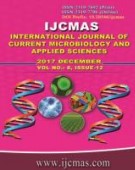


 National Academy of Agricultural Sciences (NAAS)
National Academy of Agricultural Sciences (NAAS)

|
PRINT ISSN : 2319-7692
Online ISSN : 2319-7706 Issues : 12 per year Publisher : Excellent Publishers Email : editorijcmas@gmail.com / submit@ijcmas.com Editor-in-chief: Dr.M.Prakash Index Copernicus ICV 2018: 95.39 NAAS RATING 2020: 5.38 |
Vulvovaginal candidiasis (VVC) is the most common cause of vaginitis accounting for 17 to 39% of symptomatic women. Both Candida albicans and non albicans Candida species are involved in VVC. Amongst various virulence factors proposed for Candida, Biofilm formation, Proteinase and Extracellular Phospholipases are usually implicated in its pathogenicity. Concern is also rising with respect to antifungal resistance in both Candida albicans and non albicans Candida. Present study is carried out to study virulence function and antifungal susceptibility by Vitek 2C in isolates recovered from women in reproductive age group with signs and symptoms of VVC. Three vaginal swabs from 168 women of reproductive age with vulvovaginal candidiasis were collected. Direct microscopy and Gram’s stained smear were examined for presence of budding yeast cells and pseudohyphae followed by isolation and identification of Candida species by conventional methods. The virulence factors studied were phospholipase, biofilm formation and proteinase. Antifungal susceptibility testing was carried out by VITEK 2C (Biomerieux). Vaginal swab of 55 (32.7%) subjects showed pure growth of Candida species. The most common species isolated was C. albicans (34.6%) followed by C. tropicalis (23.6%) and C. glabrata (21.8%). The production of virulence factor phospholipase was shown by most strains (83.6%) followed by biofilm formation (74.5%) and proteinase production (70.9%). MIC by VITEK-2 showed highest resistance to fluconazole (16.4%), followed by that to voriconazole (10.9%) and amphotericin B (5.4%). The study duly emphasizes the need for the determination of virulence factors and antifungal susceptibility testing for effective and prompt determination of not only the pathogenic state of candida species but also proper management of the VVC cases.
 |
 |
 |
 |
 |